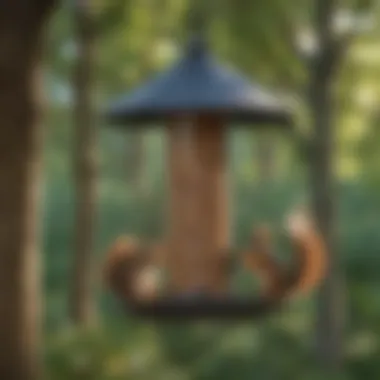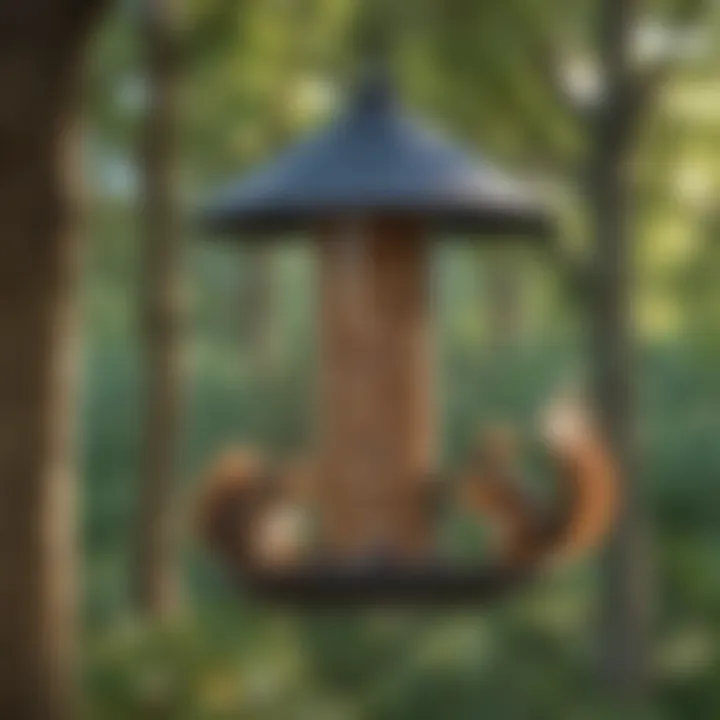Effective Strategies to Keep Squirrels Away from Bird Feeders


Intro
Squirrels can be a charming sight in backyards, but when it comes to bird feeders, they can become unwelcome guests. It's disheartening to see birds being chased away, or even worse, to find feeders emptied by these agile little creatures. This article dives into practical strategies for limiting squirrel access to bird feeders, making your garden a welcoming haven for birds instead.
From physical barriers to selective feeding techniques, we’ll discuss various methods that not only protect your bird feeders but also maintain an aesthetically pleasing environment. We will explore how to create a backyard that promotes harmony among wildlife while adhering to the design principles of your space.
By providing effective deterrents and thoughtful maintenance approaches, we aim to empower homeowners and gardening enthusiasts alike with actionable insights. Let's examine how we can implement these strategies that help in creating an ecosystem where both birds and squirrels can thrive without conflict.
Understanding Squirrel Behavior
Understanding the intricate behaviors of squirrels is fundamental when devising strategies to deter them from bird feeders. By comprehending their habits, motivations, and adaptability, homeowners can tailor their approaches to create effective barriers that genuinely work. After all, a little knowledge goes a long way, especially in nature where these clever creatures thrive. Squirrel behavior is not just about annoyance but also involves appreciating these agile animals in their natural habitat.
The Nature of Squirrels
Squirrels are often seen as pesky visitors to bird feeders, but their behaviors are deeply rooted in their nature. There are over 200 species of squirrels worldwide, but common varieties like the Eastern Gray and the Fox Squirrel are frequently found in backyards. Their physical characteristics—nimble feet and bushy tails—are designed for agility in trees and urban gardens. Moreover, their social interactions—playing, foraging, and warning calls—add layers to their behavior that many do not notice.
This adaptability is key; squirrels can adjust their routines based on food availability and environmental changes. If you observe your backyard closely, it may surprise you just how intelligent these critters can be. They are not mindless scavengers; rather, they are astute gatherers that plan for winter by hoarding nuts and seeds, often stashing them in hard-to-reach places.
Feeding Habits and Preferences
Squirrels, like most animals, have specific feeding preferences shaped by their dietary needs. They primarily consume nuts, seeds, fruits, and sometimes even insects—yes, they can be omnivorous when the situation demands it. However, bird feeders laden with sunflower seeds, peanuts, and corn are like a buffet to them. It’s essential to choose the right blend of bird food that may appeal to your backyard birds while being less enticing to squirrels.
Interestingly, squirrels are known to eat with a specific technique: they often handpick food and strip away shells or outer layers. This behavior can make them seem highly selective and picky eaters. Understanding what attracts them most can help in selecting feeders and bird food that minimize squirrel interest. So, if you want to give your feathered friends a fair chance, it’s time to get strategic about what you leave out.
Cognitive Abilities and Problem Solving
What truly sets squirrels apart is their remarkable cognitive abilities. These creatures are problem solvers by nature. Studies have shown that they can navigate complex environments and exhibit strong memory skills when it comes to locating hidden food. A squirrel can remember where it buried a nut months ago, which is quite impressive.
It's not just their memory; it's their ingenuity that often leads to them successfully raiding bird feeders. Observing this can be frustrating, as you'll see them try different techniques, leaping, climbing, and sometimes even working in teams to achieve their goal. They may initially seem like they’ve got a one-track mind in seeking food, but their varied approaches demonstrate a keen ability to adapt and improvise.
"Understanding your competition—like squirrels at a bird feeder—can help you devise strategies that not only protect your food supplies but also enhance your wildlife watching experience."
Thus, when you know the lengths squirrels will go for a treat, it empowers you to rethink your approach—whether that means investing in a squirrel-proof feeder or modifying your feeding strategy altogether. Ignoring their cleverness may leave your bird feeders vulnerable, so acknowledging this aspect of their nature is crucial for finding solutions.
Assessing Your Feeders
In the quest to keep squirrels at bay while ensuring birds are well-fed, the evaluation of your feeders becomes a crucial step. Not all feeders are created equal, and the specific attributes of your bird feeder play a significant role in how effective they are in deterring pesky squirrels. Understanding this aspect can lead to informed decisions that not only enhance your backyard but also support the local wildlife.
Types of Bird Feeders
When it comes to bird feeders, variety is more than just the spice of life; it's essential for catering to different avian species, but it can also affect squirrel access significantly. Here are a few common types:
- Hopper Feeders: These often allow squirrels easy access due to their wide openings. Opting for a hopper feeder with a weight-activated perch can deter squirrels effectively.
- Tube Feeders: Squirrels are known for their acrobatic feats, but tube feeders, particularly those with smaller feeding ports, can be quite effective. They often require the birds to cling tightly, which squirrels find tricky.
- Platform Feeders: While they attract various birds, platform feeders are like an open buffet for squirrels. Consider placing baffles or cages around these feeders to reduce access.
Each type of feeder has its pluses and minuses, so think about your specific situation, the types of birds you want to attract, and their feeding habits when making your choice.
Location of Feeders
Choosing the right spot for your bird feeders is just as important as what you put in them. Feeding stations should be strategically placed to maximize bird visits while minimizing squirrel interferences. Situate feeders close to trees or shrubs, but not too close, ideally a good distance that makes it tricky for squirrels to leap onto them.
In addition, consider:
- Height: Mounting your feeders high enough can deter squirrels, since they prefer jumping from lower vantage points.
- Avoiding pathways: Ensure your feeders aren’t right under tree branches or close to fences where squirrels have easy routes.
Taking the time to assess your feed location can make a world of difference in how many birds you see and how often squirrels raid your feeders.
Types of Bird Food


What you choose to feed the birds can also be a game changer when it comes to deterring squirrels. If you want to discourage squirrels from raiding your feeders, opting for seed types that they tend to avoid can be beneficial. Here are some choices that may help:
- Nyjer Seed: This small black seed is favored by finches but not so much by squirrels.
- Safflower Seed: Birds love this seed, while most squirrels shy away from it due to its taste.
- Peanuts in the shell: Although squirrels love peanuts, if you put them in feeders with small access holes, they might have a harder time.
By being selective with the food you offer, you can influence not just which birds come to visit but also reduce the squirrel population around your feeders.
"A well thought-out approach to assessing your feeders will create a haven for birds while keeping squirrels at a distance."
In summary, understanding the types of feeders, where they are placed, and what foods you provide will greatly influence your success in deterring squirrels. With a little time and thought, your feeding stations can become inviting spots for birds without giving squirrels a free lunch.
Physical Barriers and Feeders
Establishing physical barriers to deter squirrels is an essential strategy to protect bird feeders. Squirrels are tenacious little critters, equipped with acrobatic skills and a keen sense for food, making them formidable opponents to your bird-feeding endeavors. The focus on physical barriers and specially designed feeders can create a harmonious environment where birds can dine undisturbed while keeping pesky squirrels at bay.
Utilizing these methods not only offers a direct solution but also aligns with an ecologically sound approach by ensuring a dedicated feeding area for birds. In the following sections, we’ll delve into specific types of squirrel-resistant feeders and supplementary structures that can be installed to enhance your bird feeder setup.
Squirrel-Proof Feeders
Squirrel-proof feeders are a game changer for bird enthusiasts. These feeders are cleverly designed to keep squirrels from accessing the food while allowing birds to feed freely. Constructed with mechanisms that make it nearly impossible for squirrels to hang on or reach the seeds, these feeders come in a variety of designs and functionalities.
A common type features a weight-sensitive system. When a squirrel climbs on, the feeder’s door closes, shutting off access to the food. This innovation is fantastic because it ensures that only birds—who typically weigh less—will have access while squirrels will simply be thwarted in their attempts. Another popular option includes feeders with metal cages around the feeding ports; this helps to shield seeds from critters while still allowing small birds to land and feed with ease.
- Considerations:
- Choose a design that suits your garden space.
- Review the materials to ensure durability against weather elements.
- Look for ease of cleaning, as maintaining feeder hygiene is critical for bird health.
Cages and Baffles
Incorporating cages or baffles is another effective method to prevent squirrels from raiding bird feeders. Cages, which can be placed around feeders, work by providing a physical barrier that squirrels cannot penetrate. These can be as simple as wire mesh structures that encircle the feeder, allowing birds to get through while blocking larger intruders.
Baffles, on the other hand, are typically curved designs placed above or below feeders. They’re crafted to prevent squirrels from climbing down or jumping up to the food. When positioning your baffle, consider the height and spacing; it should be at least five feet off the ground and spaced far enough from nearby tree branches to deter an agile squirrel from making a leap.
By installing effective cages and baffles, you're not only preserving your bird feeders but also playing a part in sustaining local bird populations by giving them a secure feeding environment.
When choosing between cages and baffles, remember: effectiveness is less about the specific style and more about proper installation. Always ensure that whatever structure or feeder you select has been properly maintained to ensure it remains effective against persistent squirrels.
In summary, investing in squirrel-proof feeders, cages, and baffles can dramatically enhance your backyard birdwatching experience. These physical barriers serve as a robust defense, safeguarding your feeding stations from determined little furballs.
Alternative Feed Stations
Creating alternative feed stations is a crucial tactic in the quest to maintain a squirrel-free bird feeding environment. Not only does it allow birds to feed uninterrupted, but it also diverts squirrels' attention away from your primary feeders. Establishing separate feeding areas isn't merely about straying from tradition; it's about cultivating a more functional feeding ecosystem that benefits avian visitors while rendering squirrels less interested in your bird feeders.
Providing Separate Feeding Areas
When it comes to birds, having dedicated feeding areas can greatly enhance their experience. Imagine a scenario where you set up small trays or feeders in a less populated part of your yard. This strategic relocation provides birds a refuge where they can eat in peace. It’s worth remembering that birds are creatures of habit. They can adapt quickly to new feeding sites, and with a little patience, they’ll flock to these alternative stations.
When choosing locations for these feed stations, consider placing them in open areas with minimal cover to discourage squirrels. The idea is to make your feeders less desirable to our cheeky little friends while ensuring that the new feeding spots are inviting enough for birds.
Some essentials to consider when setting up separate feeding areas include:
- Visibility: Install them in open spaces to keep an eye on the bird activity.
- Accessibility: Choose locations that are easy for birds to spot but hard for squirrels to reach.
- Maintenance: This doesn’t mean just filling feeders; inspect them frequently for any signs of wear or rodent involvement.
Choosing Squirrel-Resistant Foods
Selecting the right type of feed can make all the difference in your battle against squirrels. The reality is that certain bird foods are less appealing to these furry intruders. Just think about it: you wouldn’t put out a buffet of their favorite snacks if you wanted to keep them at bay.
Consider using safflower seeds or thistle seed, both of which are known to deter squirrels. Not only do these seeds cater directly to many songbirds, but they’re also less attractive to squirrels. Gone are the days of tossing out sunflower seeds willy-nilly, only to see it end up as a buffet for little squirrels.
When discussing squirrel-resistant foods, it’s beneficial to keep in mind:


- Seed Types: Opt for seeds that are specially formulated for birds and not appealing to squirrels.
- Species Variances: Understand what birds you wish to attract and select foods accordingly.
- Quality Control: Ensure that the seeds you select are fresh and free from additives that might attract unwanted visitors.
By implementing these strategies, you create a haven for birds while minimizing the chances for squirrels to elbow their way into the feeding space. It’s important to remember that a little creativity and observation can go a long way in ensuring a harmonious feeding environment.
"Creating alternative feeding systems not only enhances bird visits but also customizes your wildlife experience at home."
Behavioral Deterrents
Deterring squirrels from accessing your bird feeders is not just about erecting barriers. Behavioral deterrents play a crucial role in keeping these nimble creatures at bay. By understanding how they think and behave, homeowners can implement strategies that discourage their activity around feeders without resorting to harmful methods. It’s about creating a delicate balance in your backyard ecosystem that respects the needs of all wildlife while prioritizing the feeding habits of your feathered friends.
Using Spicy Additives
Using spicy additives can be quite an interesting tactic. Squirrels, unlike birds, are sensitive to certain spices. For instance, mixing bird seed with cayenne pepper can confuse their taste buds. It’s believed squirrels tend to shy away from foods that leave a fiery aftertaste in their mouths. This method has the added benefit of not affecting the feathery visitors since birds do not have the same receptors for spiciness that squirrels do.
When applying this method, one can simply sprinkle cayenne pepper or another spicy powder over the seed. However, there are a couple things to keep in mind:
- Reapplication is key: Rain and wind can wash away the spice, so periodic reapplication is essential.
- Discretion is advised: While some spices are effective, others can be harmful in larger quantities. Always check the safety of the spices being used before adding them to the feed.
Motion-Activated Devices
Motion-activated devices can be an enjoyable yet effective tool to deter squirrels. Devices such as sprinklers or noise-emitting gadgets trigger upon detecting movement, startling squirrels into retreat. These gadgets can add a dynamic element to your backyard; an unsuspecting squirrel might find themselves unexpectedly sprayed with water, which can be quite the deterrent!
Installation is generally straightforward, as most of these devices simply require a nearby water source or batteries. One important detail to consider:
- Sustainability of annoyance: Regularly check these devices to ensure they’re functioning appropriately. A malfunctioning gadget won’t deter squirrels effectively and may also frustrate the neighborhood cats or curious birds.
Natural Predators
Emulating natural predators can serve as a formidable deterrent for squirrels. When squirrels sense the presence of threats like hawks or owls, they are likely to scatter. As a result, incorporating visual cues around your garden helps cultivate a sense of danger for them. Placing a realistic-looking owl statue atop your feeder can work wonders.
Additionally, you may consider ground-based solutions. Leave visible signs of a canine presence, like a dog’s water bowl or even strategic placement of dog toys. Not all backyards are suited for keeping dogs, but if feasible, your furry friend can serve as a natural deterrent simply by being present. Just remember to keep these areas well-maintained to prevent attracting more squirrels.
In summary, behavioral deterrents can make a significant difference when it comes to deterring squirrels from bird feeders. Through the use of spicy additives, motion-activated devices, and imitating natural predators, one can create an environment more welcoming to birds while discouraging pesky squirrel visits.
Habitat Modification
Altering the environment around your bird feeders can be a game-changer in deterring squirrels. Habitat modification involves making changes to the physical surroundings to lower the chances of squirrels accessing the feeders. This not only helps protect the food meant for birds but also fosters a well-balanced ecosystem in your backyard.
Landscape Adjustments
One practical way to tackle the squirrel issue is by making conscious decisions regarding your landscape. Have a good think about the trees and shrubs in your yard. Squirrels are expert climbers. If you have tall trees that provide easy pathways to your feeders, consider trimming back those branches that are too close to the feeder.
- Clipping Branches: A good rule of thumb is keeping branches at least 10 feet away from the feeders. This significantly reduces the climbing distance for our bushy-tailed friends.
- Plant Selection: Incorporate plants that don't offer much in terms of height or cover. Low-growing plants can create a less inviting environment for squirrels.
Besides trimming and planting, think about the layout of your backyard. A well-planned garden, utilizing natural barriers, can act as a buffer zone. Perhaps inserting rocky edges or even experimental landscapes that challenge a squirrel's agility could be beneficial.
Removing Squirrel Attractants
It’s wise to recognize what draws squirrels into our yards in the first place. They are opportunists and will take whatever is easiest.
- Eliminate Food Sources: This is essential—ensure no fallen nuts or seeds lie around. If you have trees that drop acorns or fruit, this can be a magnet. Regular cleanup routines can keep those sneaky critters at bay.
- Secure Trash and Compost: Squirrels are far from picky eaters. If you have unsecured garbage cans or compost heaps, these can provide unexpected feasts. Ensuring lids are tight or even using squirrel-proof containers makes a significant difference.
- Bird Supply Management: When it comes to birdseed, it's a good idea to strategically store leftover seeds. Store them in airtight containers, and don’t leave any excess food lying about. This makes a big impact.
By addressing these habits and the physical make-up of your space, you not only reduce squirrel encounters but create a peaceful feeding environment for the birds. Remember that the small adjustments you make today can have a substantial impact tomorrow. Modifying the habitat is not just about the feeders, but the entire ecosystem thriving around them.
"A little change can make a big difference."
By taking these considerations into account, you're fostering a home where birds can comfortably feed, all while limiting squirrel activity. Implementing these modifications requires ongoing commitment, but the results can be truly rewarding.
Maintenance and Monitoring


In the quest to create a squirrel-free environment for your bird feeders, maintenance and monitoring play a pivotal role. It's not just about setting things up and hoping for the best; it’s a continuous effort that yields tangible benefits. Regular upkeep ensures that your deterrent measures remain effective and that the feeders stay clean and inviting for the birds. Squirrel-proofing requires not only initial action but also a commitment to monitoring your environment regularly for any changes in squirrel activity or feeder performance.
Regular Cleaning Routines
A well-cleaned feeder is crucial for both the birds and the longevity of your feeding station. Dust, debris, or spoiled bird seed can attract squirrels and other pests, undermining your efforts to keep the feeders accessible only to birds.
Here are some pointers for establishing a regular cleaning routine:
- Frequency: Aim to clean your feeders every two weeks, especially in warmer months when moisture can lead to mold. A quick cleanup can deter even the most persistent squirrels.
- Cleaning Solutions: A mixture of warm water and mild soap works well. Avoid strong chemicals that might harm birds. For stubborn grime, vinegar can be an effective natural cleaner.
- Cleaning Tools: Use a soft brush to scrub away stuck seeds or dirt without damaging the feeder materials.
- Post-Cleaning Checks: After cleaning, inspect for any damage or wear. Rodents might exploit cracks or loose parts; address these issues promptly.
By maintaining a clean feeder, you not only promote healthier bird visits but also create an environment less appealing to squirrels.
Seasonal Adjustments
Squirrels and birds have distinct behaviors that fluctuate with the seasons. Thus, adapting your strategies according to seasonal changes can significantly impact your success in deterring squirrels.
Consider these adjustments:
- Winter: Squirrels may rely more on bird feeders for food during colder months. Ensure your feeders are squirrel-proof and potentially redistribute food types to less attractive options for squirrels.
- Spring: Monitor for new squirrel families, as young squirrels introduce new challenges. It might be necessary to reinforce barriers or enhance your deterrents.
- Summer: As foliage thickens, squirrels gain better access to feeders. Trim nearby trees or shrubs to eliminate potential launch pads for squirrels.
- Fall: This time of year can see heightened squirrel activity as they prepare for winter. Consciously offer birdseed that squirrels find less appetizing, like safflower seeds, and solidify physical barriers.
"The key is to adapt your strategy to the rhythms of nature. What works in one season may need tweaking for another."
Maintaining a proactive approach by adjusting your tactics throughout the year can keep squirrels at bay while ensuring birds have consistent access to their food source. Remember, it’s all about observation and being prepared to update your methods as needed.
Evaluating Success
Evaluating the success of your endeavors to deter squirrels from bird feeders is crucial. It allows you to gauge the effectiveness of your strategies and make adjustments as necessary. This assessment involves careful observation and analysis, which can lead to more harmonious interactions in your backyard. It's not just about keeping squirrels at bay; it's about ensuring a steady flow of birds to your feeders.
Monitoring Bird Activity
Keeping an eye on bird activity is where the fun starts. By observing how often birds visit your feeders, you can get a good sense of whether your current tactics are working. When birds return in droves, it usually indicates that your efforts to protect their feeding grounds are paying off.
Try this approach:
- Daily Logs: Make it a habit to jot down the types of birds you see and the times they show up. Over a few weeks, patterns may emerge. For instance, morning visits might become a daily occurrence while evenings are quieter.
- Consider Local Species: Different birds have varying feeding habits. Some may be more willing to share space with squirrels than others. Pay attention to the species that visit, as this might give clues about how to better accommodate them.
- Location Matters: If you notice certain feeders attracting fewer birds despite the same food offering, it may indicate that squirrels are still a concern, prompting a reevaluation of feeder positioning or design.
Analyzing Squirrel Interference
Understanding how squirrels interact with your feeders is equally important. Their presence—or lack thereof—can reveal whether your strategies need refinement. Keeping track of squirrel activity helps highlight the effectiveness of your deterrents.
Use these methods:
- Spotting Trends: Document when squirrels appear. Are they more active during certain seasons? Do they have favorite times of day? This data can guide your timing for refilling feeders or make it easier to determine the best defensive measures in particular conditions.
- Visual and Physical Surveys: Look for signs of squirrel activity like chewed food packaging or disturbed ground beneath feeders. If your findings point towards squirrel access, it might be time to consider enhanced barriers or different food types.
- Behavioral Changes: Sometimes, continuous observation of squirrels can provide insights into their problem-solving skills. If they seem to have found a way around your deterrents, learning their tactics will help you stay one step ahead.
Evaluating success isn’t merely about triumphs or failures; it’s an ongoing cycle of adaptation that can enhance your wildlife experience. By combining vigilant bird monitoring with thorough analysis of squirrel interactions, you ensure that your backyard remains a thriving ecosystem where birds can feed peacefully.
Ending
In wrapping up this exploration of the strategies to deter squirrels from bird feeders, it becomes clear that creating a harmonious outdoors involves a delicate balance. Birds, with their vibrant colors and melodic calls, bring joy to many homeowners, while squirrels, though often seen as pesky, play vital roles in the ecosystem. Finding the sweet spot where both can thrive requires an understanding of each creature's needs and behaviors.
Balancing Bird and Squirrel Needs
When setting up feeding stations in your yard, it’s important to consider what appeals to both birds and squirrels. Squirrels are natural foragers, hence they are drawn to food sources without barriers. Providing birds with their preferred seeds while being mindful that some might attract squirrels can lead to a less than ideal situation. Here are some strategies to balance their needs:
- Selective Nut Offerings: Offering seeds such as safflower, which birds enjoy but squirrels often bypass, can help attract feathered friends without inviting furry intruders.
- Feeder Design Consideration: Choose feeders designed specifically for birds, where the small holes limit access to larger creatures. This way, birds feast safely while squirrels are kept at bay.
- Natural Feeding Areas: Consider leaving some nuts or seeds away from feeders, giving squirrels their space to forage. This reduces competition and curtails their interest in bird feeders.
Cultivating an environment where both birds and squirrels can coexist peacefully often enhances the aesthetic and ecological value of your garden.
Final Thoughts on Deterrence Strategies
As we close, remember that the true success of your deterrence measures lies in patience and observation. Every yard is unique, and what works in one setting may not yield the same results in another. Here are some final points to bear in mind:
- Consistent Monitoring: Keep an eye on the bird and squirrel activity. Changing patterns help in tweaking your approach, adapting to the evolving dynamics of the wildlife around you.
- Flexibility is Key: Be ready to experiment. Don’t hesitate to mix strategies; sometimes a combination of physical barriers and behavioral improvements brings the best results.
- Long-Term Thinking: Solutions might take time to implement effectively. With persistence, you'll foster an environment that not only suits the birds but can also be a sanctuary for other wildlife.
Ultimately, the aim is not just deterrence but fostering an environment thriving with life, free from damaging competition. As you apply these strategies, keep the larger picture in mind: a well-planned feeder setup can open your garden to the beauty of nature while ensuring that all wildlife, including your squirrels, can thrive without squabbles.















